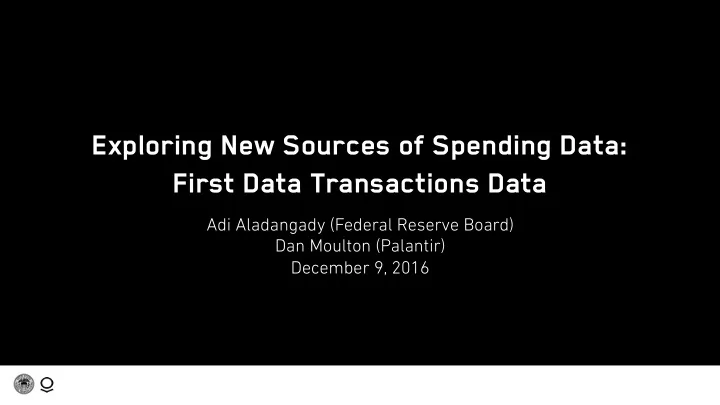

Exploring New Sources of Spending Data: First Data Transactions Data Adi Aladangady (Federal Reserve Board) Dan Moulton (Palantir) December 9, 2016
GOALS FOR USING TRANSACTION DATA AT THE FED 1. Produce a timely, independent measure of spending to improve our analysis and forecasting of national economic activity with a focus on Retail Sales 2. Use detailed cuts of the data to improve the granularity of our understanding of consumer spending behavior at the state and national level 3. Access and analyze anonymized aggregates of a new data set in a way that is not a black box 2 ¡
LESSONS LEARNED FROM PRIOR WORK WITH TRANSACTION DATA • Data cleaning, filtering, and seasonal adjustment are time consuming • Requesting data from private companies was an iterative process • Variation in the ability/willingness of different data vendors to work toward a data product that met our needs • Data received needs to ensure anonymity of individual observations and sensitive business information; understanding transformations applied to the raw data is important 3 ¡
FIRST DATA/PALANTIR: WHAT IS IT? • First Data – An electronic payments processing company that provides merchants with the technology to process credit, debit, and electronic payment transactions • Raw data is daily frequency, swipe-level transactions by merchant • Merchants are classified by MCC • Available to Board 3-5 days after transaction • Covers roughly 45% of national “core” retail sales • Palantir constructs transforms to anonymize aggregates of transactions • Transparency – Underlying code for transforms available to Fed • Collaboration – Weekly engagement model to iterate on methodology 4 ¡
PROVIDING TRANSPARENCY INTO DATA PROVENANCE 5 ¡
DATA + ANALYSIS IN ONE PLACE 6 ¡
CONSTRUCTING AGGREGATE INDEXES In its raw form, FD’s transaction data measures the activity of its business, not the U.S. economy . Working with >140 billion rows, we had to define how to isolate ‘good merchant behavior’ to build aggregates only from merchants representing real economic activity. This work included: • Controlling for merchant births and death with ‘chaining’ methodology to reflect real entry/exit of sample growth; additionally, First Data acquisitions of new platforms results in large spikes • Establishing a merchant-to-industry mapping from MCCs to 4-digit NAICS; this is particularly hard for multi-NAICS firms and e-commerce • Applying seasonal adjustment to a short time series (2012-present) where X-13 type filters have limited use; we currently match NSA 12-month growth and use Census SA factors 7 ¡
FIRST DATA/PALANTIR: HOW WELL DID IT WORK? Raw Data vs Census Retail Sales (12mo change, NSA) 8 ¡
FIRST DATA/PALANTIR: HOW WELL DID IT WORK? Filtered Index vs Census Retail Sales (12mo change, NSA) 9 ¡
CONSTRUCTING STATE-LEVEL INDEXES A similar filtering algorithm was applied to daily, state-level data to construct daily indexes of spending within a given state. These are useful for analyzing things such as effects of large storms on spending . Effect on Daily National Retail Sales Group Spending by Hurricane Source: First Data Retail volume aggregates, Census Bureau. Note: State-level spending indexes aggregated using 2012 Economic Census weights. The dots are the estimated coefficients for daily hurricane effect controlling for day of week, month, and trends. Whiskers are 95 percent confidence interval. Additional details on this analysis are available in our recently published FEDS Note. 10 ¡
SUMMARY AND FURTHER WORK • Transaction aggregates can be useful sources of independent, timely signal for aggregate spending • Requires care in constructing aggregate index • Transparency of transformations between data provider and user helps • Additional work: • Current analysis of events, tax holidays, weather events, etc. • Gathering additional history to apply X13 • Home-level data using geography of spending patterns 11 ¡
Recommend
More recommend